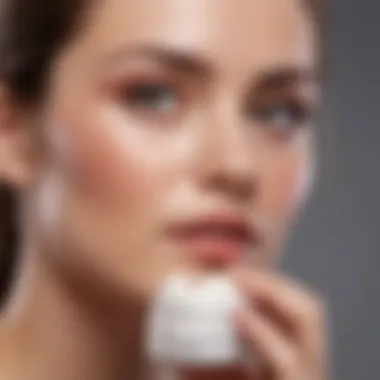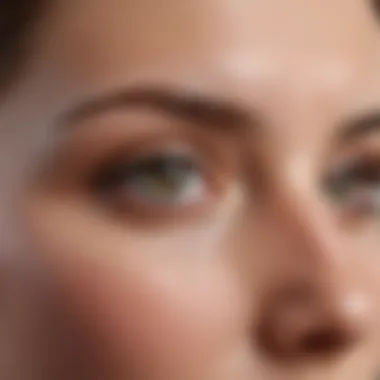Effective Methods to Conceal Puffy Bags Under Eyes


Intro
Puffy bags under the eyes affect a wide range of people, causing concerns about appearance and confidence. These bags may arise from various causes, including lack of sleep, dehydration, allergies, and even genetics. Understanding these factors is crucial for effective treatment and prevention. In this guide, we will explore a variety of methods to conceal these bags, from makeup techniques to skincare solutions. This comprehensive resource aims to provide knowledge that empowers you to look your best, no matter the occasion.
Trending Topics
Current Fashion Trends
In today's beauty landscape, makeup trends are evolving rapidly. The concept of natural beauty has gained traction, and consumers are leaning toward products that enhance their features instead of masking them entirely.
Products designed for the under-eye area, such as illuminating concealers and eye patches, are becoming highly sought after. Notable brands like Tarte and NARS have released formulations that specifically address puffiness, keeping the skin looking fresh without heavy layers. Additionally, the trend of layering products has introduced innovative combinations that include both skincare and makeup, blurring the line between the two.
Beauty Innovations
The beauty industry continues to innovate, focusing on cleaning and efficiently targeting common problems like under-eye puffiness. For instance, cooling applicators and serums infused with caffeine are popular for their immediate effects.
Moreover, brands are investing in research to create formulations enriched with natural extracts, reducing the risk of irritation. Products that combine the benefits of skincare with makeup are especially valuable, as they provide lasting results in addition to instant coverage.
Step-by-Step Guides
Fashion Styling Tips
- Choose the Right Fabrics: Wearing soft, flowy fabrics can draw attention away from facial features. Opt for designs that frame the face well.
- Accessories Matter: A statement necklace or eye-catching earrings can shift focus upward, diverting from the under-eye area.
- Right Hairdo: Consider hairstyles that frame your face, allowing soft layers to detract attention from any puffiness.
Beauty Routines
- Hydration Is Key: Drink plenty of water throughout the day. Proper hydration can help reduce puffiness significantly.
- Cold Compress: Use a cold compress or chilled spoons on the eyes for about 10 minutes. This method reduces swelling effectively.
- Proper Skincare Regimen: Utilize eye creams designed for puffiness. Look for ingredients like caffeine, peptides, and hyaluronic acid.
Product Reviews
In-Depth Analysis of Popular Items
Products are important allies in the fight against puffy eyes. Some effective items include:
- Tarte Shape Tape Concealer: Known for its coverage and skin-friendly ingredients.
- NARS Radiant Creamy Concealer: Provides a luminous finish while hiding puffiness.
- Patchology Eye Patches: Instant relief and hydration.
Comparative Reviews
Comparing products helps find the best fit for your needs. For example:
- Hydrating Eye Creams vs. Conventional Moisturizers: Hydrating eye creams usually have lighter formulas, focusing directly on the delicate under-eye area.
- Silicone-based vs. Water-based Primers: While silicone-based primers provide a smooth finish, water-based ones can feel lighter and more breathable.
Ultimately, the goal is to choose products based on skin type and specific needs.
Taking the time to understand ingredients and product compatibility is crucial for achieving the best results. This guide serves as a roadmap to navigate the myriad of options available while tackling the common issue of puffy bags under the eyes.
Understanding Eye Puffiness
Understanding eye puffiness is crucial in addressing the concern of puffy bags under the eyes. This section provides insight into the definition, common causes, and lifestyle effects on puffiness. By grasping these concepts, individuals can identify their specific triggers and implement effective strategies. Knowledge about this topic not only enhances one's ability to tackle the aesthetic issue but also increases awareness of patterns contributing to eye puffiness.
Definition of Eye Puffiness
Puffy eyes can be defined as swelling around the eye area. This swelling can occur due to various reasons, making the eyes appear tired or older. Eye puffiness often manifests as bags beneath the eyes, resulting in an uninviting appearance. Recognizing the visible signs is the first step towards managing this condition.
Common Causes of Puffiness
Genetics
Genetics play a significant role in eye puffiness. Some individuals may inherit a predisposition to have more pronounced bags under their eyes. A key characteristic of genetic influences is that they often require ongoing management rather than one-time solutions. Understanding the hereditary aspects allows individuals to approach treatments with realistic expectations. However, genetic factors can be challenging as they are uncontrollable.


Allergies
Allergies are a common cause of eye puffiness. When exposed to allergens, the body releases histamines, leading to inflammation. A critical aspect of allergies is their seasonal or environmental variability. This means that individuals may experience puffiness at different times of the year. In addition, allergies can trigger other symptoms such as redness and itchiness, amplifying the need for effective treatment strategies.
Lack of Sleep
Lack of sleep is widely recognized as a contributor to eye puffiness. It affects the body's hydration and recovery processes. Not getting sufficient rest can lead to retention of fluids under the eyes, making bags more pronounced. Prolonged sleep deprivation may result in chronic puffiness, emphasizing the importance of prioritizing sleep hygiene.
Dehydration
Dehydration impacts the skin's elasticity, contributing to eye puffiness. Without adequate hydration, the body may retain water in the eye area, resulting in visible swelling. This key characteristic of dehydration highlights the necessity of drinking sufficient water. Addressing dehydration can have broad benefits, not only for appearance but for overall health, reinforcing the importance of hydration in daily routines.
Effects of Lifestyle on Puffiness
Dietary Factors
Dietary factors significantly influence eye puffiness. High salt intake, for example, can lead to fluid retention, particularly around the eyes. Conversely, incorporating a balanced diet rich in potassium can help counteract these effects, promoting better hydration levels. The connection between diet and puffiness underscores the role of nutritional choices in skincare.
Screen Time
Excessive screen time is increasingly linked to eye puffiness. Staring at screens can strain the eyes, leading to fatigue and subsequent swelling. Recognizing the impact of screen time encourages individuals to take breaks and practice eye exercises, promoting overall eye health. Adopting conscious device usage habits can play a crucial role in managing eye puffiness.
Stress Levels
Stress contributes to multiple health issues, including eye puffiness. High stress can cause changes in the body, possibly leading to fluid retention. Managing stress through relaxation techniques and healthy activities can reduce its impact on physical appearance. This section emphasizes the need for a holistic approach to well-being, as mental health influences aesthetics.
Preventative Measures for Reducing Puffiness
Preventing puffiness under the eyes requires an understanding of its causes and implementing strategies to counteract them. These measures are essential, as they address the underlying issues rather than simply masking the symptoms. By focusing on hydration, sleep hygiene, and dietary adjustments, individuals can significantly reduce their susceptibility to puffy bags. This proactive approach not only enhances appearance but also contributes to overall well-being.
Hydration Strategies
Staying adequately hydrated is one of the simplest yet most effective methods to combat under-eye bags. Dehydration causes the body to retain water, which can lead to puffiness. Women of all ages should aim to drink enough water daily, usually around eight 8-ounce glasses. This helps maintain skin elasticity and can aid in minimizing the appearance of bags. Incorporating water-rich foods like cucumbers, oranges, and lettuce can also support hydration.
In addition to drinking water, it’s wise to monitor the intake of diuretics such as caffeine and alcohol, which can increase dehydration. Reducing these substances can be an important measure to lower water retention and puffiness.
Sleep Hygiene Practices
Quality sleep plays a crucial role in reducing under-eye puffiness. Lack of sleep can result in fluid buildup beneath the eyes, creating a swollen appearance. Establishing a regular sleep schedule is vital. Adults should aim for 7 to 9 hours of sleep each night in a dark, cool room to enhance restfulness.
Sleeping with the head elevated can also facilitate better drainage of fluids from the face. Using an extra pillow or a wedge can help achieve this. Furthermore, creating a pre-sleep routine that avoids screens and promotes relaxation can improve sleep quality and thus reduce the chances of developing puffy bags.
Dietary Adjustments
Diet significantly affects skin health, including the delicate area around the eyes. Two key dietary adjustments can be made to reduce puffiness: reducing salt intake and incorporating antioxidants.
Reducing Salt Intake
Reducing salt intake is fundamental in managing puffiness. High sodium consumption can cause the body to retain water, especially in the face.
- Key Characteristic: A diet lower in sodium helps prevent fluid retention. This is beneficial as it directly combats puffiness.
- Unique Feature: By choosing fresh foods over processed options, one can naturally lower salt intake. This charges the diet with essential nutrients without contributing to puffiness.
- Advantages: Not only does this help with puffiness, but it can also improve overall health by lowering blood pressure and reducing the risk of heart disease.
Incorporating Antioxidants
Incorporating antioxidants into the diet is another effective approach. These compounds help combat oxidative stress, which can worsen the appearance of skin. Foods rich in antioxidants including berries, leafy greens, and nuts are excellent choices.
- Key Characteristic: Antioxidants help repair skin damage and can boost skin health. This approach is beneficial as it supports overall skin vitality and elasticity.
- Unique Feature: The incorporation of diverse fruits and vegetables into meals can provide multiple forms of antioxidants, ensuring a robust nutritional profile for better skin health.
- Advantages: A diet rich in antioxidants can result not only in reduced puffiness but also in healthier skin, promoting a youthful appearance.
By prioritizing hydration, proper sleep, and a fortified diet, individuals can take effective steps towards reducing puffiness under the eyes. These preventative measures lay a strong foundation for maintaining a fresh and revitalized look.


Skincare Solutions
Skincare solutions play a crucial role in the pursuit of a fresh and revitalized appearance, especially for targeting puffy bags under the eyes. Incorporating effective skincare products can address the fundamental issues causing puffiness, while also enhancing overall skin health. The right formulations, specifically designed for the delicate under-eye area, can provide hydration, reduce inflammation, and improve circulation. These solutions not only help to conceal existing puffiness but also prevent its recurrence, making them essential tools in any beauty regimen.
Targeted Eye Creams
Targeted eye creams are formulated with active ingredients that specifically address puffiness. These creams often contain caffeine, peptides, and hyaluronic acid, all of which work to tighten the skin, reduce swelling, and improve moisture retention. Caffeine, for example, is known for its ability to constrict blood vessels, thereby minimizing the appearance of puffiness. When selecting an eye cream, look for products that are labeled as "de-puffing" or "brightening". This reassures their efficiency in addressing the specific issue of bags under the eyes. Regular application can lead to noticeable improvements over time.
Facial Masks and Treatments
Facial masks and treatments can provide an intensive boost to the skin's condition. Many brands offer eye-specific masks that deliver concentrated ingredients meant to soothe and refresh tired skin. These masks can incorporate nourishing components, such as aloe vera or green tea extracts, which are praised for their anti-inflammatory properties. Applying these masks consistently can hydrate and calm the under-eye area, and they can be particularly effective when used in conjunction with other skincare products.
Cooling Techniques
Cooling techniques are a classic remedy for puffy under-eyes. These methods emphasize the importance of reducing inflammation through temperature therapy. The soothing sensation of cold can constrict blood vessels, ultimately alleviating puffiness. Two commonly recommended cooling strategies include the use of cold spoons and chilled gel masks.
Cold Spoons
Using cold spoons is a straightforward and effective method. Place metal spoons in the refrigerator for a period of time, then apply them to the under-eye area. The chilling effect helps to reduce swelling. One of the key characteristics of cold spoons is their accessibility; you can easily use them at home without the need for fancy tools. The unique feature of cold spoons is their ability to start working quickly, delivering immediate soothing effects. Despite their simplicity, the cold technique has become a popular choice for many, proving effective in moments of urgency.
Chilled Gel Masks
Chilled gel masks take the cooling technique to another level. These masks, often filled with hydrogel or silica gel, provide a longer-lasting cold effect than cold spoons. The key characteristic of chilled gel masks is their ability to fit snugly against the skin, delivering uniform cooling across the under-eye area. These masks are beneficial because they allow for a more extended treatment period which can enhance the reduction of puffiness. However, one consideration to keep in mind is that they may need a refrigerator to maintain their chilled state. Overall, these masks offer a convenient and effective way to refresh tired eyes and mitigate puffiness.
Makeup Techniques to Conceal Puffiness
Makeup techniques to conceal puffy bags under the eyes play a significant role in enhancing one’s appearance. Puffy bags can affect how a person feels about their overall look. Employing the right makeup methods provides an immediate solution to conceal these imperfections. Additionally, these techniques can boost self-confidence during important events or in daily life. The right tools and products make it easier to achieve a refreshed look.
Choosing the Right Concealer
Selecting a proper concealer is the first step toward addressing puffiness. Opt for a lightweight formula with a creamy consistency that does not settle into fine lines. Look for concealers that have light-reflecting properties. These can illuminate under the eyes and diminish the appearance of shadows.
Consider shades that are slightly lighter than your skin tone. This gives a brighter look, which can counteract dark circles associated with puffy bags. Popular options include NARS Radiant Creamy Concealer and Maybelline Instant Age Rewind. Each provides excellent coverage while maintaining a natural appearance.
Application Techniques
Patting vs. Blending
In terms of application, patting is frequently favored over blending. Patting uses the third finger, which applies a gentle pressure. This minimizes pulling on delicate skin around the eyes. The key characteristic of patting is that it allows the product to settle without disruption. Blending, while effective for other areas, can sometimes lead to excess product movement. This may highlight puffiness rather than conceal it.
Using a sponge or finger to gently pat the concealer onto the skin is beneficial. It promotes better absorption and creates a seamless finish. For a more polished look, it might be necessary to lightly blend the edges after applying with a patting motion.
Layering Products
Layering products effectively can provide additional coverage for persistent puffiness. The key characteristic of layering is that it allows for customization of coverage levels. Start with a thin layer of concealer and build up as necessary. This technique is popular as it prevents caking, which can occur when too much product is applied at once.
This method enables adjusting the intensity based on light conditions or events. Maintain a light hand, and ensure each layer dries before applying additional products. Utilizing different types of concealers, like a color-correcting option on darker areas, can improve overall results.
Highlighting and Shadowing
Highlighting and shadowing techniques are effective in creating a visual illusion. By strategically applying lighter shades on raised areas and darker shades on puffy sections, one can sculpt the overall appearance. This contouring-like strategy manipulates light and provides depth, effectively distracting the eye from the puffiness.
Highlight the inner corner of the eye and beneath the brow bone for an illuminated effect. This draws attention upward and away from bags. Additionally, avoid shiny products which may enhance visibility of puffiness. Using matte formulations can aid in achieving a refined look.
Alternative Treatments for Persistent Puffiness
Dealing with persistent puffiness under the eyes is an issue that affects many individuals. Traditional methods, such as topical treatments and makeup, provide temporary relief but may not address the underlying causes. This section delves into alternative treatments that offer more long-lasting solutions. It highlights the significance of these methods for individuals who regularly confront this concern. Alternative treatments can restore the youthful appearance of the under-eye area and enhance self-confidence.
Dermal Fillers


Dermal fillers are a popular choice for reducing the visibility of puffy bags under the eyes. These treatments involve the injection of substances like hyaluronic acid into specific areas, which can plump up the skin and smooth out the contours. The primary benefit of dermal fillers is their ability to provide immediate results, making them an appealing option for those seeking rapid improvement.
However, consideration is crucial. The longevity of fillers varies, typically lasting several months to a year. Patients may also experience temporary swelling or bruising post-treatment. Choosing a qualified professional for this procedure is essential to avoid complications.
Laser Treatments
Laser treatments offer another alternative for persistent puffiness. This method employs focused beams of light to target the skin around the eyes. Laser technology can help tighten the skin and stimulate collagen production. These multifunctional benefits can lead to a more rejuvenated appearance over time.
The effects of laser treatments are often cumulative, meaning that multiple sessions may be necessary for optimal results. As with any procedure, potential risks include discomfort and adverse skin reactions. Therefore, a thorough consultation with a dermatologist is recommended to evaluate suitability before proceeding.
Surgical Options
For individuals seeking a more permanent solution to under-eye puffiness, surgical options may be considered. Procedures like blepharoplasty involve the removal of excess fat and skin around the eyes, effectively lessening the appearance of puffiness. This surgical intervention can yield significant, lasting results.
Notably, this option requires a recovery period and comes with potential risks associated with surgery. Patients should weigh the pros and cons thoroughly, often discussing with a specialist about expected outcomes and recovery timelines.
"Eye treatments have evolved, offering diverse options to address puffy bags. It is essential to choose the path that aligns with your personal needs."
In summary, alternative treatments for persistent puffiness under the eyes present several avenues. Dermal fillers, laser treatments, and surgical options cater to different preferences and needs. Each method has its own set of benefits and considerations, making it vital for individuals to do thorough research and consult with professionals before making decisions.
Long-Term Approaches to Eye Care
Understanding how to address puffy bags under the eyes requires attention not only to quick fixes but also to long-term strategies. Long-term approaches to eye care focus on sustainable practices that improve overall eye health and appearance. These strategies help to reduce the frequency and severity of eye puffiness, leading to a more refreshed and vibrant look over time. Establishing a routine, conducting periodic professional assessments, and committing to continuous education are fundamental components of this proactive approach.
Establishing a Routine
Building an effective skincare routine is essential in managing eye puffiness. This involves incorporating eye creams that contain beneficial ingredients such as caffeine, peptides, and hyaluronic acid. Caffeine can help constrict blood vessels, reducing swelling. Peptides promote skin elasticity, while hyaluronic acid aids in hydration. A daily application of these products can create a cumulative effect, progressively improving the appearance of the under-eye area.
Consistency in this routine is vital. Individuals should apply these treatments both morning and night. Additionally, integrating a gentle massage technique during application can enhance lymphatic drainage, further decreasing puffiness. A regular routine not only brings visible results but also instills a sense of self-care that can be beneficial for overall well-being.
Periodic Professional Assessments
Another important aspect of long-term eye care involves scheduling periodic visits to skincare professionals. These assessments can provide insights into the specific causes of under-eye puffiness and inform adjustments to your skincare regimen. Dermatologists may recommend specialized treatments tailored to individual skin types and concerns.
Regular check-ups also allow for early detection of skin issues that may contribute to puffiness. Procedures that might be suggested during these visits include chemical peels, which promote skin renewal, or laser treatments that target surface imperfections. By seeking professional guidance, individuals can adapt their routines based on expert advice, ensuring the most effective strategies are employed.
Continuous Education on Skincare
Staying informed about skincare trends and advancements is crucial for anyone looking to manage or eliminate under-eye puffiness effectively. This involves researching new products and techniques, as well as understanding the latest skin science. Resources such as skincare blogs, expert articles, and relevant forums can provide valuable information.
Engaging with the community can also offer practical insights. Knowledge on ingredients, formulations, and potential allergens can empower consumers to make informed choices. Furthermore, continuous education fosters an evolving skincare approach, allowing adjustments as the skin changes over time.
"Investing in skincare knowledge yields long-term benefits that pave the way for healthier skin."
Overall, long-term approaches to eye care emphasize the importance of routine, professional guidance, and ongoing education. By adopting these strategies, individuals can enhance their eye health and minimize puffiness, leading to a more confident appearance.
Epilogue
In summation, addressing puffy bags under the eyes is more than just a cosmetic concern; it revolves around self-image and personal well-being. This article delves into effective strategies that cater not only to immediate remedies but also to long-term solutions. By understanding the causes and implementing preventive measures, individuals can improve the appearance of their under-eye area significantly.
Recap of Effective Strategies
The key methods explored include:
- Hydration: Maintain adequate water intake to keep skin plump.
- Sleep Hygiene: Quality sleep is crucial. Aim for seven to nine hours nightly.
- Dietary Adjustments: Decreasing salt consumption plays a vital role. Prioritize fruits and vegetables rich in antioxidants.
- Skincare Solutions: Products containing caffeine can help diminish puffiness. Incorporating cooling techniques, such as chilled spoons or gel masks, can also be beneficial.
- Makeup Techniques: Choosing the right concealer and utilizing effective application methods, like patting, will significantly aid in camouflaging bags.
- Alternative Treatments: Options such as dermal fillers or laser treatments may be suitable for persistent issues.
This collective knowledge empowers individuals to take a holistic approach to manage under-eye puffiness, thereby enhancing not just their appearance but their overall confidence.
Encouragement for Individual Approach
As every individual's skin and circumstances vary, a tailored approach is vital. Experiment with various strategies until you discover what works best for you. One should not shy away from seeking professional advice when necessary. This could involve periodic assessments from dermatologists or skincare experts who can guide personalized treatments.
Moreover, understanding one’s unique triggers for puffiness—whether lifestyle-related or hereditary—can illuminate effective preventative strategies. Emotional well-being should also be considered; sometimes reducing stress can be as crucial as topical treatments.
Ultimately, knowledge is power. By applying the insights gathered here, readers can develop an effective regime that aligns with their specific needs. As puffy eyes can be a common concern for all ages, empowering oneself with the right information paves the way for a confident and revitalized appearance.



